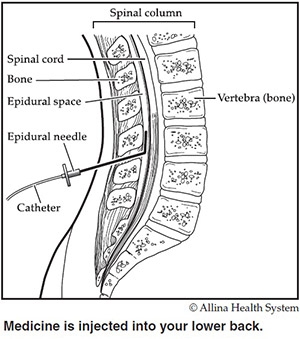

Guided imagery for pregnancy and birth
The tracks on the Guided Imagery for pregnancy and birth album will assist you with relaxation, pain control, healing and breastfeeding.
Labor epidural
Somali: Dhabar-duridda foosha (epidural)

A labor epidural is a procedure used to control pain during childbirth. This procedure is done by an anesthesia provider who may be an anesthesiologist (medical doctor) or a certified nurse anesthetist.
The anesthesia provider inserts a small catheter (thin plastic tube) into your lower back. The tip of the catheter rests in the area just outside the spinal cord. This area is called the epidural space. Medicines to control labor pain are given through the catheter.
The anesthesia provider will review your chart and ask you questions about your health and pregnancy. He or she will want to make sure that an epidural is right for you and that you understand the risks of the procedure.
How the labor epidural catheter is placed
- You will sit bent over or lie on your side.
- The anesthesia provider will carefully clean your lower back and then numb your skin. You may feel a slight stinging (like a mosquito bite or bee sting) for a few seconds.
- After the skin is numb, the anesthesia provider will place an epidural needle into your back. You will feel pressure.
- He or she will thread the epidural catheter through the needle. You may feel an electric-type pain in your back which can travel down your leg. This is normal.
- After the catheter is in place, the anesthesia provider will remove the needle and tape the catheter to your lower back.
Effects of the labor epidural
You may have these effects:
- Your blood pressure may drop and will need to be checked often. If your blood pressure drops, you may be treated with a medicine to raise it.
- You may notice warmth, tingling and numbness from your toes to your belly button. This is normal.
- Your contractions will seem a little shorter and less intense. You will receive medicine during labor so you stay comfortable until your baby is born. It takes about 20 minutes for the medicine to work fully. The goal of an epidural is to provide pain relief. Epidural anesthesia will make your contractions feel less intense and allow you to relax during your labor. Epidurals do not always provide complete pain relief.
- Once the epidural takes effect, you need to stay in bed. Your legs can become weak, and it will not be safe for you to walk around. A Foley catheter (another type of small plastic tube) may be placed in your bladder to drain urine since you won't be able to get up and go to the bathroom. The Foley catheter is placed after the epidural and is usually not uncomfortable.
- Itching can occur. You may be treated with a medicine to relieve the itching.
After your baby is born, the epidural catheter is removed from your lower back. The tingling and numbness will slowly go away over a few hours.
Mother baby care
A wide variety of videos on topics ranging from labor and delivery to newborn and postpartum care can be found on our Allina Health mother baby care video page.
Giving birth: Managing pain
- Cesarean birth (five video topics)
- Vaginal birth (five video topics)
Breastfeeding
Breastfeeding your baby is available in English, Arabic, Hmong, Russian, Somali and Spanish.
Benefits of a labor epidural
A labor epidural:
- provides pain relief during labor and your baby's birth
- is safe for your baby
- may be used as an anesthetic for a Cesarean birth
- may be used for tubal ligation surgery (tube tying) after delivery
Epidurals do not increase the chance that you will need to have a Cesarean birth.
Risks of a labor epidural
Possible risks of a labor epidural include the following.
- You may get a headache. (One to three percent of women do.)
- Your lower back may become tender at the catheter entry site.
- Your blood pressure may drop.
- You have a slight risk (1 in 150,000) of:
- bleeding around your spinal cord
- infection near your spinal cord
- injury to your spinal cord
- Your baby faces minimal risks. (You may breastfeed your baby as soon as you are ready after the birth.)
- Rare risks include respiratory and cardiac arrest.
Other ways to control labor pain
There are other ways to control pain during labor and birth. Your health care provider may also suggest:
- support of partner or doula
- breathing and focusing exercises
- hydrotherapy tubs, showers
- massage
- aromatherapy
- pain medicine (a narcotic) injected into a vein or muscle
- single dose of medicine injected around your spinal cord (intrathecal narcotics)
If you have questions or concerns, please talk with your health care provider.

Guided imagery for pregnancy and birth
The tracks on the Guided Imagery for pregnancy and birth album will assist you with relaxation, pain control, healing and breastfeeding.